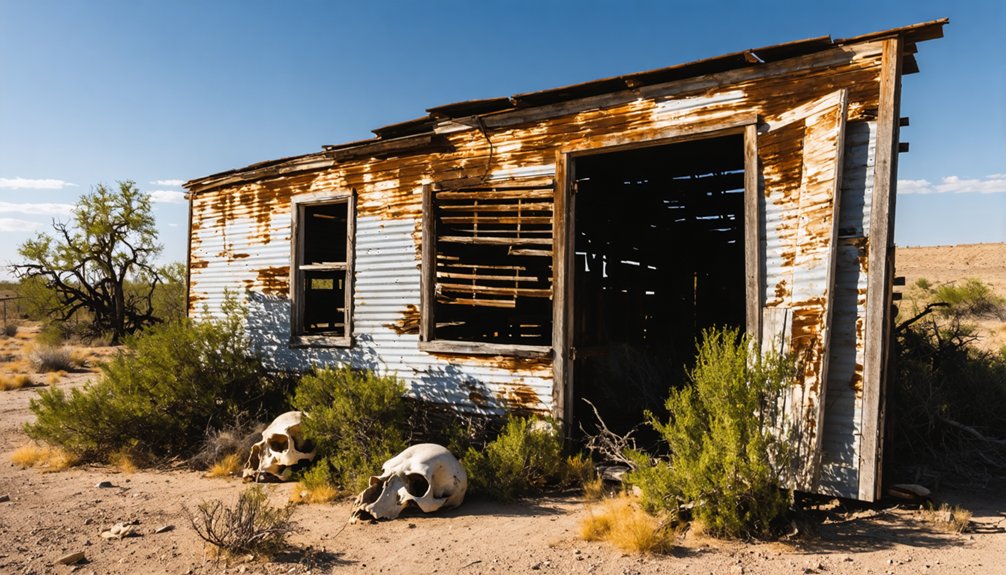You’ll find Dias E Ocho Creek Camp, a World War I-era military outpost turned ghost town, nestled in the remote desert terrain of Presidio County, Texas. From 1914 to 1918, U.S. cavalry units stationed here conducted border patrols against Pancho Villa’s revolutionary forces. Today, the privately-owned site features archaeological remnants of military barracks, supply depots, and lookout points. The camp’s rich history of border defense and frontier settlement protection holds many untold stories.
Key Takeaways
- Dias E Ocho Creek Camp operated from 1914-1918 as a military outpost in Presidio County, Texas during the Mexican Revolution.
- The ghost town site contains archaeological remains of barracks, supply depots, and military artifacts from early 20th century U.S. Army operations.
- Located on private Quinn Ranch property, approximately 6 miles west of Fort Holland, the site requires owner permission to visit.
- The camp served as part of a defense network against Pancho Villa’s forces, conducting cavalry patrols and border surveillance missions.
- Archaeological discoveries include building foundations, military hardware, army buttons, and ammunition, preserving the site’s historical significance.
The Birth of a Border Defense Post
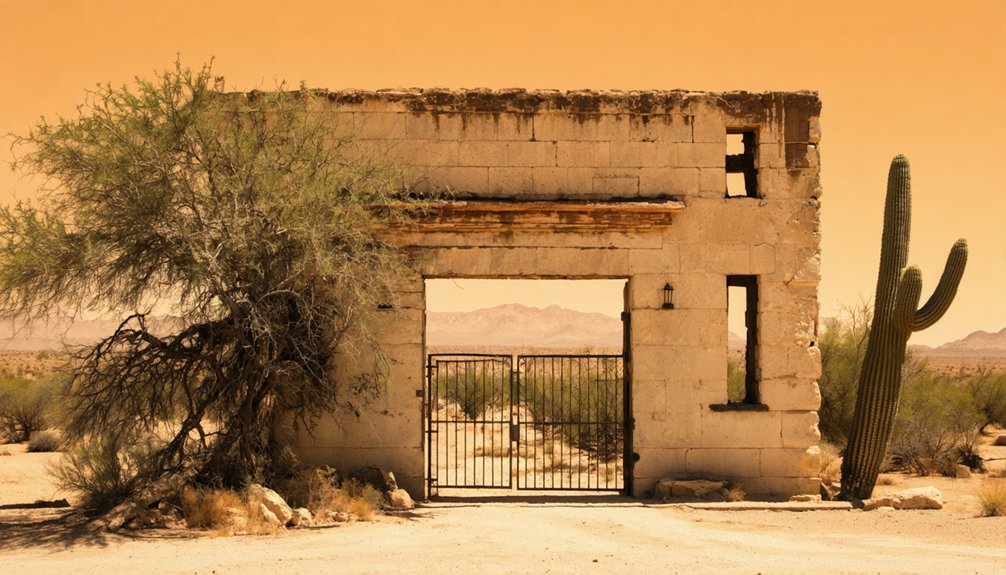
As revolutionary violence swept through northern Mexico in 1914, the U.S. Army established Dias e Ocho Creek Camp in Presidio County, Texas to counter mounting border threats.
You’ll find this military outpost was strategically positioned on Quinn Ranch property, where the rugged terrain provided natural advantages for border security operations. The camp operated similarly to Camp Santa Helena, conducting regular cavalry patrols along the border.
The camp emerged as part of a broader network of defense posts, including nearby Fort Holland, designed to protect American communities from raids by Pancho Villa‘s forces and other revolutionary groups.
A strategic chain of American defense posts along the border stood guard against Villa’s raiders during Mexico’s revolutionary upheaval.
The military presence served a critical role, as U.S. forces weren’t permitted to pursue raiders into Mexican territory. Instead, they’d maintain vigilant watch from fortified positions, ready to intercept cross-border incursions that threatened Texas settlements and infrastructure during this turbulent period of Mexican revolutionary activity. The site remained operational throughout World War I before being abandoned shortly after the conflict ended.
Military Operations and Strategic Importance
Three core military functions defined Dias e Ocho Creek Camp’s operations from 1914 onward: border patrol, reconnaissance, and rapid response capabilities.
You’ll find the camp’s military strategy centered on coordinating with Fort Holland and nearby posts to maintain a vigilant defense network against Pancho Villa’s raiders and other hostile groups crossing from Mexico.
The camp’s strategic positioning in Presidio County let troops monitor key border crossing points while supporting broader U.S. efforts during the Mexican Revolution. After its decline, it became one of many Texas ghost towns along the border region.
Similar to today’s enhanced surveillance operations, soldiers conducted mounted patrols, gathered intelligence, and maintained communication lines across the rugged terrain. They’d deploy quickly to hotspots of border conflicts, operating from fortified positions that enhanced surveillance capabilities.
This integrated approach effectively curbed cross-border violence and protected American settlements during a volatile period in Texas borderland history.
Daily Life at Dias E Ocho Creek Camp
You’ll find soldiers at Dias E Ocho Creek Camp living in basic barracks while maintaining a demanding schedule of border patrol duties and training exercises.
Your typical day at camp would involve rotating shifts of guard duty, equipment maintenance, and monitoring the Texas border for threats from Francisco Villa’s forces. Armed with revolvers and Bowie knives, soldiers remained vigilant while conducting their patrols and defensive operations.
You’d have managed limited supplies and rations carefully, as the camp’s remote desert location meant sporadic deliveries of fresh food and water from external sources. The camp was situated in rolling terrain typical of northeastern Texas, which provided strategic vantage points for surveillance.
Soldiers’ Daily Camp Routines
Life at Dias E Ocho Creek Camp followed a rigidly structured military routine that emphasized combat readiness and border security. You’d start your day with daily inspections and roll calls, followed by intensive training exercises designed to maintain peak combat effectiveness.
Soldier camaraderie grew through shared hardships as you worked together maintaining the camp’s fortifications and equipment. Similar to modern border patrol agents, soldiers dealt with the challenges of monitoring a militarized zone that transformed the once-quiet region. Like today’s agents working extended shifts due to migrant surges, troops often endured lengthy deployments at their posts.
- Dawn-to-dusk patrols along the Texas border to monitor bandit activity and secure the perimeter
- Regular combat drills and physical fitness training to guarantee readiness for potential threats
- Scheduled maintenance of weapons, structures, and essential camp facilities
- Evening debriefings and strategic planning sessions for next-day operations
Your daily life centered around strict military discipline, with limited personal time between duties, always staying vigilant for potential hostile encounters along the frontier.
Border Patrol Watch Duties
While stationed at Dias E Ocho Creek Camp, your border patrol duties encompassed rigorous surveillance operations across challenging terrain.
You’d spend long hours monitoring for illegal crossings through dense brush and remote desert areas, often relying on cameras, sensors, and radio equipment to cover vast stretches of land.
Your daily patrols required extraordinary physical endurance and mental alertness. With recent changes, agents now possessed state arrest authority for handling dangerous felony suspects at checkpoints.
You’d conduct vehicle and pedestrian checkpoint inspections, questioning travelers while watching for suspicious behaviors. Processing detainees often meant placing them in holding cells with uncomfortably cold temperatures.
The harsh environment tested your resilience – extreme heat, humidity, and isolation became constant companions.
You’d navigate through difficult terrain using solar-powered communication devices to maintain contact with your team.
Working individually or in groups, you’d remain vigilant against potential threats while carrying out your enforcement duties.
Military Housing and Supplies
Located on private Quinn Ranch land, Dias E Ocho Creek Camp featured basic military infrastructure designed for temporary border defense rather than permanent residency.
Military logistics centered on maintaining essential supplies for soldiers stationed at this remote outpost. The barracks-style soldier accommodations maximized functionality while providing basic shelter from the harsh desert environment.
- Basic provisions included preserved rations, ammunition, and standardized military-issue clothing
- Water and fuel supplies required constant monitoring due to the camp’s isolated location
- Medical supplies consisted of first aid kits and basic treatment materials
- Equipment maintenance facilities supported patrol vehicles and weapons systems
The camp’s supply chain relied heavily on nearby Fort Holland, with deliveries arriving via rail or wagon routes to sustain the troops’ daily operations and border defense missions.
The Mexican Revolution’s Influence
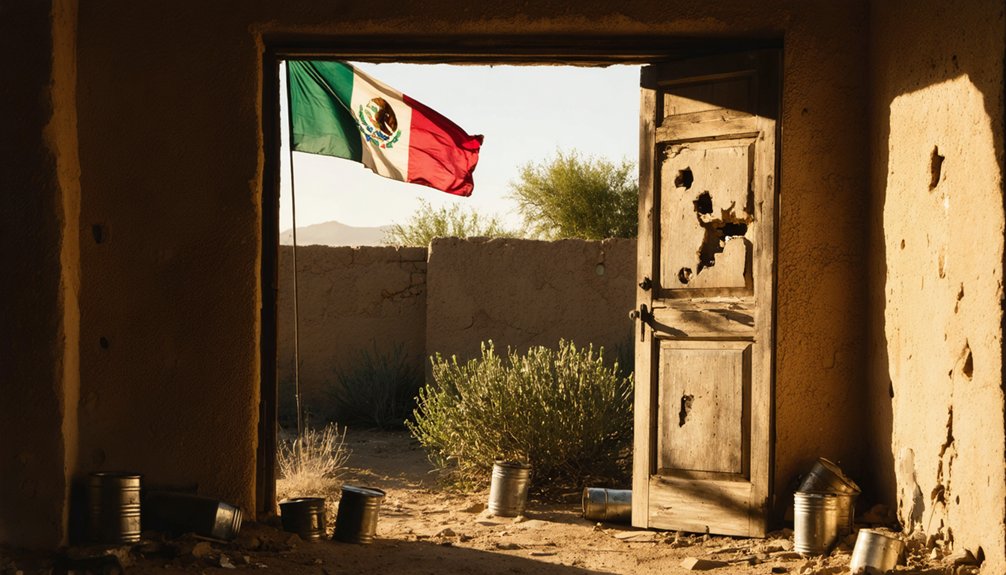
During the Mexican Revolution of 1910-1920, Dias E Ocho Creek Camp and its surrounding region experienced profound transformations amid widespread border instability.
You’d have witnessed increasing tensions as raids and violence swept across the Texas-Mexico border, from Brownsville to El Paso. The area’s demographic makeup shifted dramatically as Mexican immigrants fled the revolution, strengthening cultural identity in border communities like Dias E Ocho.
Local residents faced displacement, property destruction, and threats of violence, while many rural Tejanos were forced into urban areas. The revolution’s impact sparked political activism among Mexican-American youth by the 1930s.
The region’s economy suffered as ranching and farming operations were disrupted, while cross-border trade diminished under the shadow of military operations and revolutionary incursions.
Architecture and Infrastructure
As military needs grew amidst the revolution’s turmoil, Dias E Ocho Creek Camp emerged with distinctly utilitarian architecture and infrastructure. The camp design prioritized defensive capabilities and rapid deployment, featuring temporary structures built from local timber and metal hardware.
You’ll find the remains of what was once a strategic outpost, positioned six miles west of Fort Holland near the Rio Grande.
Key features of the camp’s infrastructure included:
- Barracks and administrative buildings constructed for basic soldier housing
- Supply depots for storing ammunition, food, and military equipment
- Strategic lookout points and guard posts for border surveillance
- A network of dirt and gravel roads connecting to major supply routes
The camp’s practical layout supported border patrol operations while maintaining essential communication with nearby military installations.
Notable Events and Historical Moments
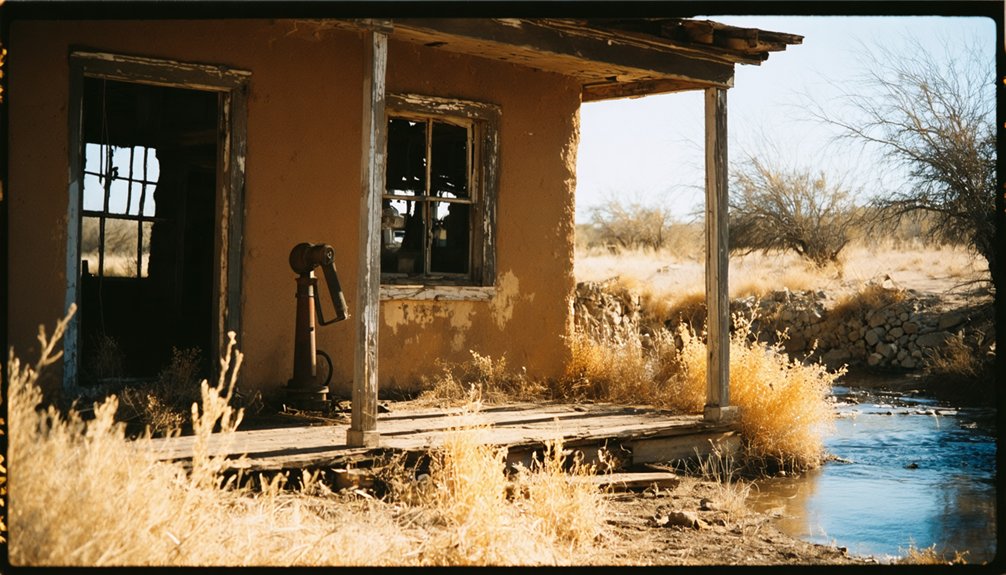
You’ll find that Dias E Ocho Creek Camp‘s most significant period occurred during 1914-1918, when its soldiers conducted intensive patrols against Francisco Villa’s forces threatening the Texas-Mexico border.
The camp’s strategic position near the Rio Grande proved essential in monitoring illegal crossings and suppressing bandit raids during World War I, while supporting broader U.S. military efforts to maintain border security.
The camp’s operational significance diminished after World War I ended, leading to its abandonment as border tensions eased and strategic priorities shifted elsewhere.
Border Patrol Operations History
The United States Border Patrol emerged as a formal law enforcement agency on May 28, 1924, when Congress established it through the Labor Appropriation Act. Early border security efforts focused on enforcing immigration policies between ports of entry, with the first field offices opening in Detroit and El Paso.
- You’ll find that initial operations relied heavily on horseback patrols, though by 1935 they’d incorporated vehicles and radio communications.
- During WWII, agents took on expanded roles, including coastal watches for enemy submarines and guarding POW facilities.
- The 1952 immigration law granted agents authority to search vehicles anywhere in the U.S.
- Operation Wetback in 1954 marked a significant shift in enforcement strategy, resulting in over 1 million returns to Mexico through various methods including airlift, boatlift, and train transport.
Villa’s Threats and Response
During the tumultuous
Post-WWI Camp Abandonment
Following World War I’s conclusion in 1918, Dias e Ocho Creek Camp faced rapid changes as its military significance diminished.
The U.S. Army’s shifting military strategy led to the camp’s abandonment as the threat from Pancho Villa’s forces decreased.
You’ll find the camp’s historical significance reflected in its evolution from an active border defense post to a silent witness of early 20th-century military operations.
- The camp’s structures deteriorated naturally, leaving only scattered remnants like old timbers and military artifacts.
- Access became restricted as the site transformed into private property within Quinn Ranch.
- Border defense responsibilities shifted to larger permanent installations like Fort Holland and Camp Marfa.
- The abandonment marked the end of frontier-style military camps in favor of modern defense positions.
Abandonment and Decline
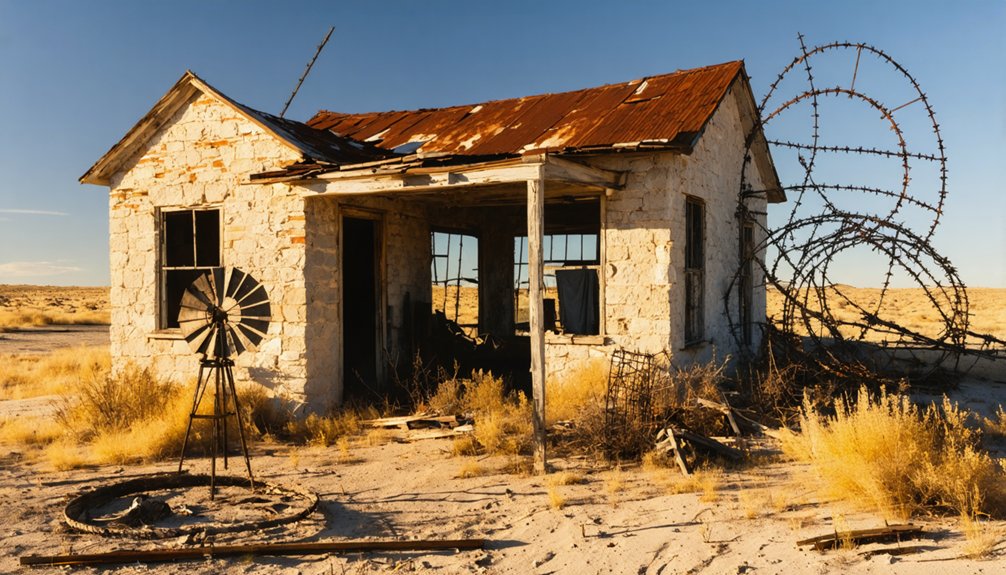
Once prosperous and vibrant, Dias E Ocho Creek Camp fell into steep decline as critical industries faltered and economic opportunities vanished.
The economic impacts rippled through the community as agricultural setbacks and railroad losses triggered widespread business closures. You’d have seen empty storefronts, vacant homes, and crumbling infrastructure as investors pulled out and building permits ceased.
Despite attempts at community resilience, younger residents aged 16-26 departed for urban areas seeking better prospects.
The town’s isolation deepened when highway realignments bypassed the settlement, while harsh Texas weather battered local agriculture.
Natural disasters, from floods to droughts, dealt additional blows to the struggling population. With each departure, the tax base shrank further, making it impossible to maintain essential services and hastening the town’s abandonment.
Archaeological Discoveries
Archaeological evidence at Dias E Ocho Creek Camp reveals extensive structural remains through foundation post-holes, indicating multiple habitation areas and shelters that you’ll see clearly outlined in the soil layers.
You’ll find concentrated deposits of worked stone tools, including diagnostic dart and arrow points, alongside burned rock middens that showcase intensive food processing activities spanning both Archaic and Late Prehistoric periods.
The site’s material culture includes specialized quarrying tools, ground stone implements, and diverse faunal remains that demonstrate sophisticated resource exploitation strategies by its prehistoric inhabitants.
Excavated Military Equipment Finds
Military excavations at Dias e Ocho Creek Camp have yielded an extensive collection of U.S. Army artifacts from the early 20th century, primarily spanning the pre- and post-World War I period.
You’ll find remarkably preserved military equipment thanks to the region’s dry, arid climate. Using advanced techniques like ground-penetrating radar and metal detection, archaeologists have carefully mapped and recovered items that tell the story of frontier military operations.
- Small arms components including rifle parts, cartridge casings, and bayonet fragments
- Cavalry equipment such as horse tack and mounted unit gear
- Uniform hardware featuring period-specific buttons and belt buckles with military insignia
- Communication remnants and signal equipment near former command post locations
Artifact preservation efforts include specialized corrosion treatments for metal objects to prevent further deterioration of these historical treasures.
Building Foundation Remnants
Beyond the military artifacts, the building foundation remnants at Dias E Ocho Creek Camp reveal intricate details about the site’s structural history. Through foundation analysis, you’ll find circular patterns of postholes indicating wooden structures, with hearths and fire-cracked rock concentrations marking living areas.
You’ll notice evidence of repeated construction phases, where buildings were rebuilt or modified over time. The structural patterns show both enclosed houses and open-sided buildings, typically constructed near water sources in fine sandy loam soil.
You’ll discover concentrations of food remains, stone tools, and flint workshops integrated within these foundation sites. Charred botanical remains and animal bones near the foundations indicate food processing areas, while the presence of paint pebbles and sandstone pipes suggests diverse cultural activities around these dwellings.
Legacy in Texas Border History
Although relatively short-lived, Dias e Ocho Creek Camp’s impact on Texas border history extends far beyond its brief operational period from 1914 to 1918.
You’ll find its cultural impact woven into local folklore, representing a pivotal moment when federal forces actively defended Texas sovereignty during the turbulent Mexican Revolution era.
- The camp served as a symbol of U.S. commitment to protecting frontier settlements and commerce.
- Its strategic positioning helped suppress Pancho Villa’s cross-border raids.
- The military presence enabled agricultural development in Presidio County’s fertile valley.
- Its operations established lasting precedents for border security tactics.
Today, while only remnants remain on Quinn Ranch, the camp’s legacy persists as a reflection of Texas’s enduring spirit of independence and determination to secure its borders.
Visiting the Ghost Town Today
Located on the privately-owned Quinn Ranch in Presidio County, Texas, Dias e Ocho Creek Camp sits approximately 6 miles west of Fort Holland and requires special permission for access.
You’ll need a 4WD vehicle to navigate the gravel roads leading to this ghost town preservation site, which you can reach by heading south from Van Horn via Highway 90 and turning near Lobo.
While visiting, you’ll find old timbers, military hardware, and relics like army buttons and ammunition.
For the best experience, plan your trip during spring or fall to avoid extreme temperatures.
Remember, there’s limited cell service and no facilities on-site.
The private ownership status has helped protect the site from vandalism, but you’ll need the owner’s permission for any artifact hunting or metal detecting activities.
Frequently Asked Questions
What Indigenous Tribes Inhabited the Area Before the Camp Was Established?
Like shifting sands of time, you’d find Native tribes such as the Karankawa and Atakapa made their historical impact here first, later joined by migrating Comanche and Apache peoples.
How Many Soldiers Were Typically Stationed at the Camp at Once?
You’ll find that soldier rotations kept troop numbers fluid, but evidence suggests 50-150 men were typically stationed there, matching similar border patrol posts’ strength during the 1914-1918 period.
Were There Any Civilian Settlements or Communities Near the Camp?
You wouldn’t find much civilian life around the camp during its operation. The nearest established town was Chinati, but it wasn’t close by, and the surrounding area remained largely unpopulated.
Did Any Notable Military Officers Serve at Dias E Ocho Creek Camp?
Like searching Netflix for a blockbuster, you won’t find any documented notable officers in the military history of this camp. Historical records don’t mention specific commanding figures serving there.
What Happened to the Military Equipment When the Camp Was Abandoned?
You’ll find the military equipment was systematically transferred to larger posts like Fort Bliss after camp abandonment in 1918, with mule trains and wagons hauling supplies through established supply lines.
References
- https://www.wikiwand.com/en/articles/Dias_e_Ocho_Creek_Camp
- https://justapedia.org/wiki/Dias_e_Ocho_Creek_Camp
- https://discovertexasoutdoors.com/places/dias-e-ocho-creek-camp/
- https://www.ghosttowns.com/states/tx/tx_ghst_twns_sect1345.doc
- https://www.northamericanforts.com/West/tx-sw.html
- https://kids.kiddle.co/Dias_e_Ocho_Creek_Camp
- https://en.wikipedia.org/wiki/List_of_ghost_towns_in_Texas
- https://www.ghosttowns.com/states/tx/diaseochocreekcamp.html
- https://www.armyupress.army.mil/Portals/7/military-review/Archives/English/MilitaryReview_20080831_art008.pdf
- https://www.heritage-history.com/index.php?c=read&author=sabin&book=border&story=mexico
